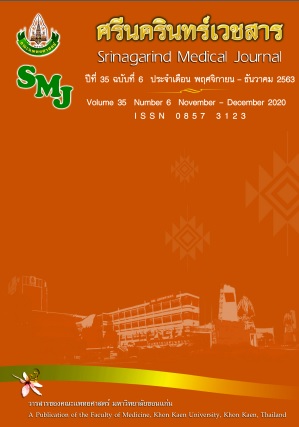Relationships between Heart Rate Variability, Motor Impairments and Level of Disability in Chronic Ischemic Stroke Patients
Abstract
ความสัมพันธ์ระหว่างความแปรปรวนของอัตราการเต้นของหัวใจ กับความบกพร่องทางระบบประสาทสั่งการและระดับความพิการในผู้ป่วยโรคหลอดเลือดสมองชนิดสมองขาดเลือดระยะเรื้อรัง
ณัฐชยา ชนแดน1,2, พรรณรายณ์ พูลศิริ1,2, สุกัญญา ศรีสวัสดิ์1,2, สุจิตรา มีสีบัว1,2, โอฬาร อิสริยะพันธุ์1,2, ปฏิวัติ โชติมล3, ดวงนภา รุ่งพิบูลโสภิษฐ์4, เบญจรัตน์ แสงทอง5, เกริกเกียรติ จินดา6, วรุณนภา ศรีโสภาพ1,2*
1หน่วยวิจัยวิทยาศาสตร์การออกกำลังกายและการฟื้นฟู ภาควิชากายภาพบำบัด คณะสหเวชศาสตร์ มหาวิทยาลัยนเรศวร จังหวัดพิษณุโลก
2ภาควิชากายภาพบำบัด คณะสหเวชศาสตร์ มหาวิทยาลัยนเรศวร จังหวัดพิษณุโลก
3ภาควิชาเทคโนโลยีหัวใจและทรวงอก คณะสหเวชศาสตร์ มหาวิทยาลัยนเรศวร จังหวัดพิษณุโลก
4หน่วยประสาทวิทยา ภาควิชาอายุรศาสตร์ คณะแพทยศาสตร์ มหาวิทยาลัยนเรศวร จังหวัดพิษณุโลก
5คณะกายภาพบำบัด และเวชศาสตร์การกีฬา มหาวิทยาลัยรังสิต กรุงเทพมหานคร
6ภาควิชาสรีรวิทยา คณะวิทยาศาสตร์การแพทย์ มหาวิทยาลัยนเรศวร จังหวัดพิษณุโลก
7หน่วยงานเวชศาสตร์ฟื้นฟู โรงพยาบาลพุทธชินราช จังหวัดพิษณุโลก
หลักการและวัตถุประสงค์: ความบกพร่องของระบบประสาทอัตโนมัติที่ควบคุมหัวใจ ประเมินโดยค่าความแปรปรวนของอัตราการเต้นของหัวใจ (Heart rate variability: HRV) มีความสัมพันธ์กับความบกพร่องของระบบประสาทสั่งการรยางค์ในผู้ป่วยโรคหลอดเลือดสมองระยะเฉียบพลัน การศึกษาครั้งนี้มีวัตถุประสงค์เพื่อ ทดสอบความสัมพันธ์ระหว่าง HRV กับความบกพร่องของระบบประสาทสั่งการ และระดับความพิการในผู้ป่วยโรคหลอดเลือดสมองชนิดสมองขาดเลือดระยะเรื้อรัง
วิธีการศึกษา: อาสาสมัครโรคหลอดเลือดสมองระยะเรื้อรัง (6-72 เดือน) ถูกคัดเลือกเข้าร่วมการศึกษา โดยอาสาสมัครสามารถยืนเองอย่างน้อย 5 นาที และทำตามคำสั่ง 2 ขั้นตอนได้ ประเมิน HRV ในท่านอนหงาย เป็นเวลา 20 นาที ประเมินความบกพร่องของระบบประสาทสั่งการรยางค์ส่วนบนและส่วนล่าง และระดับความพิการ ด้วยแบบประเมิน Fugl-Meyer Assessment (FMA) และ Modified Rankin Scale (mRS) ตามลำดับ ทดสอบความสัมพันธ์ระหว่างตัวแปรโดยใช้สถิติ Spearman’s correlation coefficients ที่ระดับนัยสำคัญทางสถิติ p<0.05
ผลการศึกษา: ผลการศึกษาพบความสัมพันธ์เชิงบวกระดับปานกลาง ระหว่างความบกพร่องของระบบประสาทสั่งการรยางค์ส่วนบน (FMA-UEs) กับ อัตราส่วนความถี่ต่ำในหน่วยมาตรฐาน (LF (nu)) (r=0.622; p=0.02) และ อัตราส่วนความถี่ต่ำ (LF) ต่อความถี่สูง (HF) (LF/HF ratio) (r=0.561; p=0.04) นอกจากนี้ยังพบความสัมพันธ์เชิงลบระดับสูง ระหว่างค่า LF nu (r=-0.855; p<0.001) และ LF/HF ratio (r=-0.711; p=0.006) กับระดับความพิการ
สรุป: ความแปรปรวนของอัตราการเต้นของหัวใจในผู้ป่วยโรคหลอดเลือดสมองชนิดสมองขาดเลือดระยะเรื้อรังมีความสัมพันธ์กับความบกพร่องของระบบประสาทสั่งการรยางค์ส่วนบน และระดับความพิการ
คำสำคัญ: ความแปรปรวนของอัตราการเต้นของหัวใจ; โรคหลอดเลือดสมองชนิดสมองขาดเลือด; ความบกพร่องของระบบประสาทสั่งการ; ระดับความพิการ
Abstract
Background and objective: Cardiac autonomic dysfunction that is measured by heart rate variability (HRV) is associated with motor impairments of acute chronic stroke patients. The purposes of this study were to investigate the association between HRV, motor impairments and disability level in chronic ischemic stroke patients.
Methods: Thirteen individuals with chronic stroke (6-72 months) were included. They were required to have the ability to stand independently for at least 5 minutes and could follow 2 step commands. Participants were evaluated their HRV for 20 minutes in supine position. Upper and lower extremities motor impairments and level of disability were assessed by Fugl-Meyer assessment (FMA) and modified Rankin Scale (mRS), respectively. Spearman’s correlation coefficients were used to investigate the association between outcome measures. Differences were considered statistically significant at p<0.05.
Result: The results showed moderate positive correlations between upper extremity motor impairments (FMA-UEs) and low-frequency power in normal units (LF (nu)) (r=0.622; p=0.02), and low-frequency to high- frequency power (LF/HF) ratio (r=0.561; p=0.04). Furthermore, there were strong negative correlations between level of disability and LF nu (r =-0.855; p<0.001), and LF/HF ratio (r=-0.711; p=0.006).
Conclusion: HRV of chronic ischemic stroke is associated with upper extremity motor impairments and level of disability.
Keyword: Heart Rate Variability; Ischemic Stroke; Motor Impairment; Disability Level


